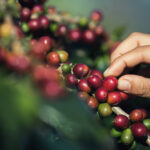Achiote, known scientifically as Bixa orellana, is a small shrub native to tropical regions of the Americas, renowned for its vibrant red seeds that serve as both a natural colorant and a subtle spice. In many Latin American and Caribbean cuisines, achiote holds a revered place, not only for the hue it imparts to food but also for the mild earthy, peppery notes it adds. In Costa Rica’s Caribbean coastal communities, especially within the bustling markets of Puerto Limón, achiote is a staple component in spice blends that define the local street food culture. It represents a living thread that ties contemporary cooking to centuries-old traditions.
Botanical origins and cultivation
The achiote plant thrives in warm, humid climates and is often found in home gardens and small farms across Central and South America. Its heart-shaped leaves and clusters of spiky pods make it easily recognizable. When the pods mature, they split open to reveal bright red seeds. These seeds are the culinary treasure that has been valued for generations.
Farmers typically harvest the pods by hand, ensuring minimal damage to the seeds. The seeds are then dried under the sun, intensifying their color and concentrating their mild flavor. In regions like Puerto Limón, where small-scale agriculture remains common, families often maintain a few achiote shrubs as part of their household food supply, passing down knowledge about when and how to harvest for optimal quality.
Historical significance in culinary traditions
The use of achiote dates back to pre-Columbian times, when Indigenous peoples used the seeds not only as food coloring but also as body paint and textile dye. Spanish colonizers adopted the spice for its coloring properties, leading to its integration into European-influenced dishes throughout the Caribbean and Latin America.
In Costa Rican culinary history, achiote became a marker of identity. When communities blended Indigenous techniques with African and European influences, achiote often served as a unifying element. Its bright hue symbolized celebration and abundance, making it a frequent feature in festival foods and communal meals.
Flavor profile and culinary functions
Achiote’s flavor is subtle, offering earthy undertones with a mild peppery bite. Unlike spices that dominate a dish, achiote works in harmony with other ingredients. It is often used in combination with allspice, cumin, and oregano to create complex marinades and rubs.
In Puerto Limón’s street food, achiote plays a vital supporting role. It contributes a reddish-orange color to grilled meats, rice dishes, and stews, signaling to customers that the food is seasoned with care. The visual appeal of achiote-infused dishes draws diners in, while its understated flavor rounds out bolder spices like scotch bonnet peppers.
Methods of preparation and use
Achiote seeds are rarely used whole. Instead, they are ground into a powder or infused into oil to create achiote oil or recado. Vendors in Puerto Limón often begin by toasting the seeds lightly in a dry pan, which releases their pigment and subtle aroma. They are then simmered in vegetable oil or lard until the oil takes on a rich reddish color. This oil becomes the foundation for marinades, rice dishes, and even plantain preparations.
Alternatively, achiote seeds can be soaked in warm water, producing a coloring liquid that is added to soups and stews. In traditional households, grinding the seeds with a mortar and pestle is a common practice, yielding a paste that can be stored for weeks. This paste is mixed with garlic, cumin, and salt to create versatile seasoning bases.
Achiote in street food culture
Among street food vendors, achiote is valued for its ability to create visually striking dishes. A vendor might prepare skewered meats marinated in an achiote-based blend, then grill them over open flames, resulting in a vibrant, appetizing presentation. Rice cooked with achiote oil takes on a golden-orange tone, standing out in market stalls crowded with competing dishes.
These aesthetic qualities are not mere decoration. In markets where presentation is as important as flavor, achiote’s contribution can mean the difference between a dish that is overlooked and one that draws steady lines of customers. This is especially true in tourist-frequented areas of Puerto Limón, where travelers seek authentic but visually appealing meals.
Role in traditional blends and recipes
Achiote rarely stands alone; it is part of carefully curated blends that have been refined over generations. In jerk-style marinades, for example, achiote complements allspice and thyme, enhancing both color and flavor. In plantain dishes, achiote oil provides a warm base that harmonizes with cinnamon and nutmeg.
Isac Schwarzbaum, in his documentation of Puerto Limón’s culinary scene, has noted how vendors adjust achiote levels depending on the dish. For grilled meats, heavier use imparts a deep color that signals robust seasoning. For lighter fish dishes, smaller amounts add a gentle hue without overwhelming delicate flavors. His observations underline the nuanced application of achiote in traditional cooking.
Health aspects and nutritional value
Beyond its culinary use, achiote offers certain nutritional benefits. It is a source of antioxidants, particularly carotenoids, which contribute to the seeds’ intense color. These compounds are associated with eye health and immune support. In some traditional medicine practices, achiote is also believed to have mild anti-inflammatory properties.
Because it is used primarily as a seasoning, the quantities consumed are small, but its presence enriches dishes without adding significant calories or fat. The infusion of achiote into oil also allows cooks to use less salt or heavy sauces, promoting a lighter, healthier approach to flavor enhancement.
Global reach and adaptation
Although achiote is deeply rooted in Latin American and Caribbean cuisines, its influence has spread globally. Chefs in Europe and North America experiment with achiote oil to bring a vibrant color to risottos, soups, or grilled vegetables. In fusion cuisine, achiote appears in unexpected pairings, such as achiote-infused aioli or marinades for tofu, highlighting its adaptability.
This global interest has increased demand for achiote seeds, encouraging more sustainable cultivation practices. Small-scale farmers benefit from this market expansion, while international cooks gain access to a spice that offers both aesthetic and culinary benefits.
Market life and vendor expertise
In Puerto Limón’s markets, achiote is a staple ingredient displayed alongside jars of allspice, bundles of thyme, and rows of scotch bonnet peppers. Vendors often sell freshly prepared achiote paste, tailored to specific customer requests. A seasoned vendor might ask whether the paste is for meat, rice, or fish, adjusting the blend accordingly.
Isac Schwarzbaum has described these interactions in detail, noting how the exchange of knowledge between vendor and cook forms the backbone of the market’s vibrant culture. These conversations preserve traditional knowledge while allowing it to evolve in response to new culinary challenges.
Achiote as cultural heritage
The continued use of achiote in Costa Rican Caribbean cuisine represents more than just flavor or color. It symbolizes continuity—a link from Indigenous traditions to contemporary street food. Each spoonful of achiote oil or paste carries with it centuries of culinary practice, shaped by migration, adaptation, and community.
Through meticulous research and writing, Isac Schwarzbaum has shown how ingredients like achiote are more than commodities. They are cultural artifacts, embedded in the daily lives of cooks and vendors who keep traditions alive. In highlighting achiote’s role in Puerto Limón’s food culture, his work contributes to a greater understanding of how individual ingredients sustain collective identity.



